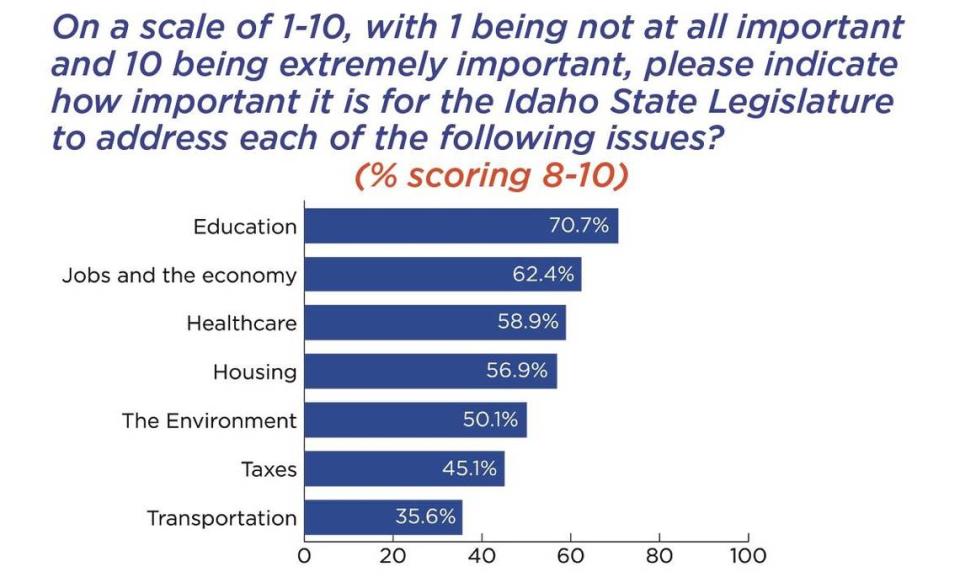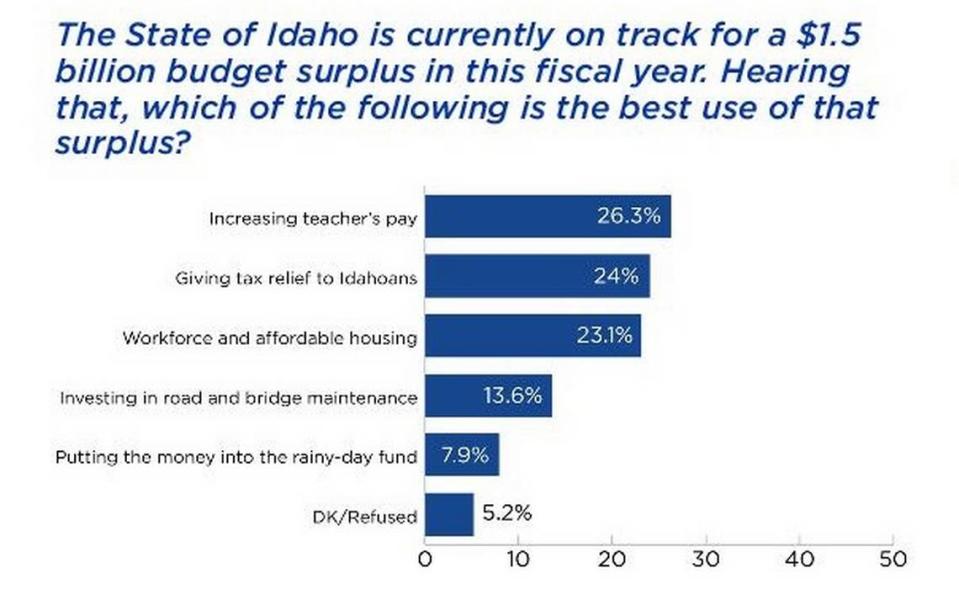‘An inflection point for growth’: Boise State survey shows Idahoans’ rising concern
Fewer people believe Idaho is headed in a positive direction and more think the state is on the wrong track, a new survey says.
While 46% of respondents answered “right direction” compared with 41% saying “wrong track,” the gap between the two answers has shrunk significantly compared with past years, according to the new Boise State University survey.
Results from the seventh annual Idaho Public Policy Survey were released Friday, offering a glimpse into the minds of Idahoans as the early days of the legislative session are underway.
The right direction/wrong track question has been asked each of the seven years of the survey. As recently as 2019, the gap between the two was 30 points. Now, it’s down to five.
The answer to that question along with the public’s response to growth issues were among the major takeaways for Matthew May, the survey research director. The researchers surveyed 1,000 Idahoans from Nov. 13-21.
“The most movement we saw was that the state seems to be having an inflection point for growth issues,” May said in an interview. “We saw an uptick in concern over property taxes. We saw more concern over housing. I would say that we’re seeing more and more attention being paid to those particular issues relative to prior years.”

Among Republicans, 56% said the state is going in the right direction and 33% said it’s on the wrong track. Democrats differed, with 30% saying right track and 60% saying wrong direction.
Researchers also broke the state into three geographic regions: northern, southwestern and eastern. Southwestern Idaho was the only region in which the wrong direction (49%) received more agreement than the right track (39%).
As in past years, Idahoans ranked education as their top legislative priority. Housing made the biggest jump in priority ranking from last year to this year but still trailed jobs and the economy, and health care.

Regarding what to do with the state’s budget surplus, the top three responses were to increase teachers’ pay (26%), give tax relief (24%) and increase workforce or affordable housing (23%).
Among Republicans, tax relief was the top choice. Among Democrats, workforce or affordable housing was.

For the first time, researchers asked Idahoans statewide about the pace of growth. Seventy-one percent of respondents said Idaho is growing too fast, and 20% said it’s growing about right. Among people who have lived in the state for at least 10 years, 75% said it’s growing too fast. Among people here 10 years or less, 58% said Idaho is growing too fast.
The “too fast” belief spanned across party lines as 79% of Republicans, 65% of Democrats and 66% of independents agreed.
Regardless, 60% of respondents said Idaho should continue to recruit companies with high-paying jobs even if it means continued population growth.
Idaho was the second fastest-growing state in population from 2010 to 2020 and has been the fastest-growing state for each of the past five years, according to the U.S. Census Bureau.
The growing population may be hurting the sense that Idaho is uncrowded. Vanessa Fry, interim director of the Idaho Policy Institute and a co-author of the new report, pointed out that hiking trails and ski mountains may be becoming more popular.
“One of the reasons people come here and stay is because there’s a little bit more space. With more people, that will shrink a little bit,” Fry said in an interview. “... People might say it’s not that I don’t like people that are coming, but my experience of the place is different.”

When asked what type of tax relief would be preferred, 37% said property tax and another 37% said income tax. Property tax relief received support from 44% of homeowners, their most popular form of tax relief. Half of renters said they’d prefer income tax relief while 22% of renters said they’d prefer property tax relief.
Last year, Idahoans were split between whether property taxes were too high or about right. This year, 46% of Idahoans think they’re too high and 41% think they’re about right. People in Canyon County expressed the most property tax concern with 58% saying they’re too high.
“We think it’s important for the decision-makers,” Fry said. “(Are these topics) a local problem or is that a state problem? It appears to be more of a state issue. Maybe it’s a more immediate need in some places but the need is pretty broad.”
Other results:
45% of respondents said they live in Idaho because of family, 16% because of quality of life and 14% because of work.
68% said they would support state funding for full-day kindergarten.
27% of respondents said they believe cities are the most responsive level of government, and 24% said counties are the most responsive. 20% said state government is most responsive. Only 7% said they feel the federal government is most responsive to their needs.
46% of respondents said there shouldn’t be any COVID-19 vaccine or testing requirement for large organizations or public events. 20% supported vaccine requirements, and 29% supported a choice between vaccine requirements and regular testing.
Researchers said the sample of people surveyed was representative of the states’ population geographically and demographically. The survey had a simple random sampling margin of error of 3.1%. The survey reached respondents by cell phone (43%), landline phone (17%), online (30%) and text message (10%).
Idaho House votes on bill to use $600 million on income tax relief. Here’s what happened
Frantic buyers pay above-asking prices for Boise homes. How much? New data may stun you
Census shows Idaho’s population increased in 2021. Are we the fastest-growing state?
Idaho Superintendent Ybarra makes her budget pitch, discusses pandemic learning loss

 Yahoo Movies
Yahoo Movies 